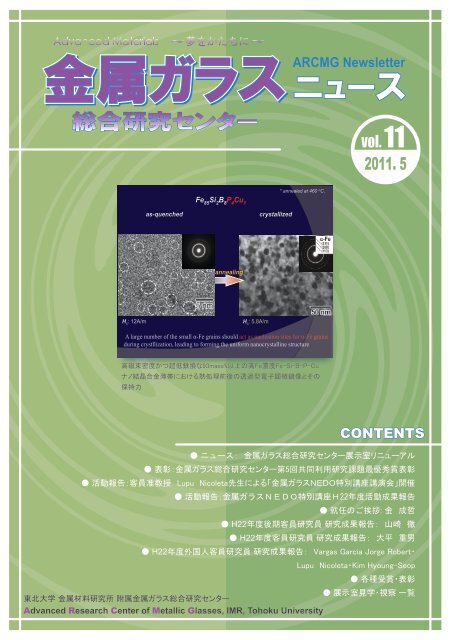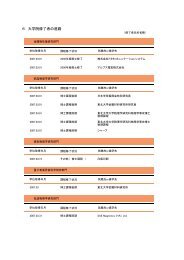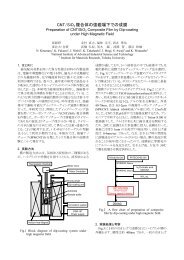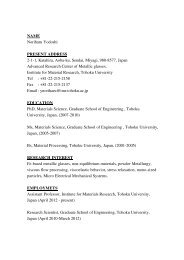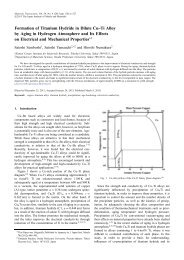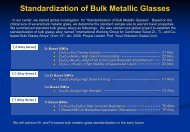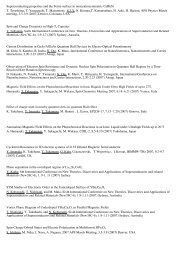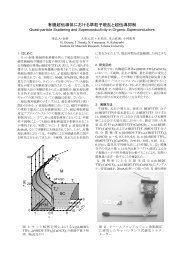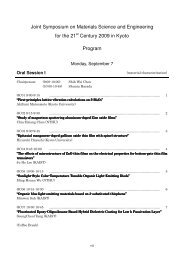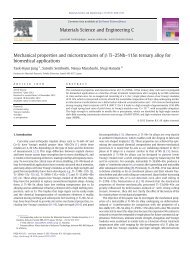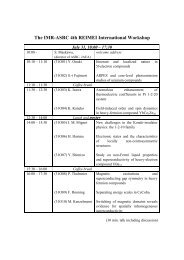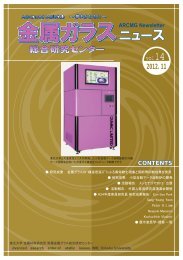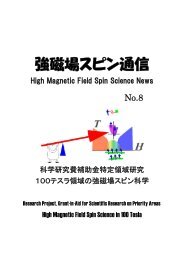ARCMG Newsletter - éå±ã¬ã©ã¹ - æ±å大å¦
ARCMG Newsletter - éå±ã¬ã©ã¹ - æ±å大å¦
ARCMG Newsletter - éå±ã¬ã©ã¹ - æ±å大å¦
Create successful ePaper yourself
Turn your PDF publications into a flip-book with our unique Google optimized e-Paper software.
金 属 ガラス<br />
総 合 研 究 センター<br />
<strong>ARCMG</strong> <strong>Newsletter</strong><br />
ニュース<br />
vol. 11<br />
2011. 5<br />
* annealed at 460 o C.<br />
Fe 85<br />
Si 2<br />
B 8<br />
P 4<br />
Cu 1<br />
as-quenched<br />
crystallized<br />
annealing<br />
H c : 12A/m<br />
H c : 5.8A/m<br />
A large number of the small -Fe grains should act as nucleation sites for -Fe grains<br />
during crystllization, leading to forming the uniform nanocrystalline structure<br />
高 磁 束 密 度 かつ 超 低 鉄 損 な93mass% 以 上 の 高 Fe 濃 度 Fe-Si-B-P-Cu<br />
ナノ 結 晶 合 金 薄 帯 における 熱 処 理 前 後 の 透 過 型 電 子 顕 微 鏡 像 とその<br />
保 持 力<br />
CONTENTS<br />
● ニュース: 金 属 ガラス 総 合 研 究 センター 展 示 室 リニューアル<br />
● 表 彰 : 金 属 ガラス 総 合 研 究 センター 第 5 回 共 同 利 用 研 究 課 題 最 優 秀 賞 表 彰<br />
● 活 動 報 告 : 客 員 准 教 授 Lupu Nicoleta 先 生 による「 金 属 ガラスNEDO 特 別 講 座 講 演 会 」 開 催<br />
● 活 動 報 告 : 金 属 ガラスNEDO 特 別 講 座 H22 年 度 活 動 成 果 報 告<br />
● 就 任 のご 挨 拶 : 金 成 哲<br />
● H22 年 度 後 期 客 員 研 究 員 研 究 成 果 報 告 : 山 崎 徹<br />
● H22 年 度 客 員 研 究 員 研 究 成 果 報 告 : 大 平 重 男<br />
● H22 年 度 外 国 人 客 員 研 究 員 研 究 成 果 報 告 : Vargas Garcia Jorge Robert・<br />
Lupu Nicoleta・Kim Hyoung-Seop<br />
● 各 種 受 賞 ・ 表 彰<br />
● 展 示 室 見 学 ・ 視 察 一 覧<br />
東 北 大 学 金 属 材 料 研 究 所 附 属 金 属 ガラス 総 合 研 究 センター<br />
Advanced Research Center of Metallic Glasses, IMR, Tohoku University
金 属 ガラス 総 合 研 究 センターニュース Vol. 11<br />
平 成 23 年 3 月 11 日 には、 東 北 地 方 太 平 洋 沖 地 震 により、 本 センターも 少 なからず 損 害 を 被 りましたが、<br />
本 センター 職 員 は 一 致 団 結 して、この 未 曾 有 の 災 害 を 乗 り 越 え、 前 進 しております。<br />
今 後 とも 益 々 努 力 してまいりますので、ご 支 援 ご 鞭 撻 を 賜 りますよう 宜 しくお 願 い 申 し 上 げます。<br />
金 属 ガラス 総 合 研 究 センター<br />
センター 長 後 藤 孝<br />
ニュース<br />
金 属 ガラス 総 合 研 究 センター 展 示 室 リニューアル<br />
金 属 ガラス 総 合 研 究 センターでは、 現 在 年 間 約 200 名 程 の 見 学 者 を 受 け 入 れております。 近 年 、 展 示 物 が 増 加 してき<br />
たこと、 見 学 者 からの「 材 料 を 作 製 している 様 子 を 見 学 したい」という 希 望 を 受 け、 展 示 物 と 実 験 の 様 子 が 見 学 出 来 る 展<br />
示 室 を 目 指 し、 昨 年 度 から 大 々 的 な 改 修 工 事 を 進 めております。 従 来 の 展 示 室 よりも 展 示 スペースを 倍 増 させ、 大 勢 のお<br />
客 様 がお 見 えになられても 対 応 可 能 となりました。また、 展 示 室 と 隣 接 している 実 験 室 との 境 をガラス 張 りにすることに<br />
より、 単 ロール 液 体 急 冷 法 によるアモルファス 合 金 リボンの 作 製 やバルク 金 属 ガラスの 鋳 造 風 景 を 見 学 することが 可 能 に<br />
なりました。( 文 責 : 横 山 嘉 彦 )<br />
表 彰<br />
金 属 ガラス 総 合 研 究 センター 第 5 回 共 同 利 用 研 究 課 題 最 優 秀 賞 表 彰<br />
平 成 23 年 5 月 23 日 、 金 属 ガラス 総 合 研 究 センター 共 同 利 用 研 究 課 題 最 優 秀 賞 表 彰 式 が 行 われました。<br />
この 賞 は、 共 同 利 用 研 究 の 促 進 のため 前 年 度 の 採 択 課 題 のうち 審 査 委 員 による 高 得 点 採 択 課 題 および 顕 著 な 成 果 を 上 げ<br />
た 採 択 課 題 を 候 補 とし、その 中 から 2 件 程 度 を 東 北 大 学 金 属 材 料 研 究 所 附 属 金<br />
属 ガラス 総 合 研 究 センター 共 同 利 用 研 究 課 題 最 優 秀 賞 として 表 彰 するもので、<br />
平 成 22 年 度 は 下 記 の 2 名 が 受 賞 されました。<br />
「 金 属 ガラス 粒 子 を 分 散 させた 磁 性 体 マイクロパターンの 光 造 形 とテラヘルツ<br />
波 制 御 」<br />
大 阪 大 学 接 合 科 学 研 究 所 桐 原 聡 秀 ( 共 同 研 究 対 応 教 員 加 藤 秀 実 )<br />
「RNbO 4 :Mn の 合 成 と 磁 性 に 関 する 研 究 」<br />
九 州 工 業 大 学 大 学 院 工 学 研 究 院 古 曵 重 美 ( 共 同 研 究 対 応 教 員 湯 葢<br />
邦 夫 、 宍 戸 統 悦 ) ( 文 責 : 横 山 嘉 彦 )<br />
1
金 属 ガラス 総 合 研 究 センターニュース Vol. 11<br />
活 動 報 告<br />
客 員 教 授 Lupu Nicoleta 先 生 による<br />
金 属 ガラスNEDO 特 別 講 座 講 演 会 開 催<br />
平 成 22 年 12 月 9 日 、COE 棟 セミナールーム 1 にて「 金 属 ガラスNEDO 特 別 講 座 学 内 講 演 会 」が 開 催 され、 金 属 ガラス<br />
総 合 研 究 センター 客 員 准 教 授 National Institute of Research and Development for Technical Physics 主 任 研 究 員 Lupu<br />
Nicoleta 先 生 にご 講 演 いただきました。Lupu 先 生 には、“Fe-TM-B-based Glassy Alloys with Enhanced Soft Magnetic<br />
Properties”と 題 し、Fe 系 非 平 衡 軟 磁 性 材 料 の 開 発 研 究 とその 発 現 する 磁 性 物 質 に 関 する 内 容 を 中 心 にお 話 しいただきまし<br />
た。 今 回 のご 講 演 は 金 属 ガラス/ナノ 結 晶 を 学 ぶ 学 生 の 皆 さんや、 金 属 ガラス 関 連 分 野 に 携 わる 多 くの 方 々が 聴 講 し、また<br />
とない 貴 重 な 機 会 となりました。( 文 責 : 山 浦 真 一 )<br />
就 任 挨 拶<br />
金 属 ガラス 総 合 研 究 センター 教 育 研 究 支 援 者<br />
金 成 哲<br />
私 は 今 春 、 金 属 ガラス 総 合 研 究 センター 牧 野 研 究 室 において 博 士 課 程 を 修 了 し、4 月 1 日 より 牧 野<br />
先 生 のもとで 同 センターの 教 育 研 究 支 援 者 として 引 き 続 きお 世 話 になることになりました。<br />
平 成 20 年 に 工 学 研 究 科 に 入 学 して 以 来 、 学 生 として 大 変 お 世 話 になりました。 牧 野 先 生 、 山 浦 先<br />
生 をはじめ、 事 務 の 方 々、 仲 間 の 学 生 の 皆 さんに 支 えていただき、お 陰 様 で 大 変 充 実 した 学 生 生 活<br />
を 送 ることができました。<br />
私 の 学 生 時 代 の 研 究 テーマは、 金 属 ガラス・アモルファス 合 金 で 被 覆 した 新 規 な 固 体 高 分 子 型 燃<br />
料 電 池 用 セパレ-タの 創 製 と 電 気 的 評 価 です。 金 属 ガラスで 被 覆 した 新 しい 燃 料 電 池 セパレータを<br />
試 作 し、その 評 価 を 行 いました。4 月 からは 牧 野 先 生 のご 指 導 の 下 、 軟 磁 性 ナノ 結 晶 材 料 の 製 造 技 術<br />
に 関 する 研 究 を 行 っております。 牧 野 研 究 室 で 見 出 された Fe-Si-B-P-Cu ナノ 結 晶 材 料 は 優 れた 磁 気 特 性 を 示 し、 実 用 化 が 望 まれ<br />
ています。 私 は 本 研 究 室 で 見 出 されたナノ 結 晶 磁 性 材 料 の 主 に 幅 広 薄 帯 や 粉 末 の 作 製 技 術 に 関 する 研 究 を 幅 広 く 行 いたいと 考 え<br />
ております。<br />
金 属 ガラス・ 非 平 衡 金 属 材 料 の 錚 々たる 先 生 方 が 結 集 しているこの 金 研 において、 今 後 一 年 間 研 究 生 活 を 送 れることは、 私 にとっ<br />
て 大 変 幸 運 なことです。これまで 多 くの 諸 先 生 方 が 築 いて 来 られた 歴 史 と 伝 統 に 恥 じぬよう、また、 自 分 らしさを 忘 れないよう、 高 い 志<br />
を 持 って、 当 センターの 発 展 に 貢 献 すべく 努 力 して 参 ります。 今 後 ともどうぞ 宜 しくご 指 導 の 程 お 願 い 申 し 上 げます。<br />
2
金 属 ガラス 総 合 研 究 センターニュース Vol. 11<br />
金 属 ガラス NEDO 特 別 講 座 H22 年 度 活 動 報 告<br />
金 属 ガラスNEDO 特 別 講 座 は 平 成 20 年 10 月 に 発 足 し、 今 春 で 早 や 三 回 目 の 春 を 迎 えました。 本 NEDO<br />
講 座 は 金 属 ガラス 総 合 研 究 センター 内 に 拠 点 を 置 いて 活 動 を 行 っておりますので、これを 機 に 本 講 座 の<br />
昨 年 度 (H22 年 度 )の 活 動 報 告 をさせていただきたいと 思 います。<br />
● 金 属 ガラス NEDO 講 座 の 事 業 項 目<br />
金 属 ガラス NEDO 講 座 の 活 動 は 次 の 三 つの 研 究 開 発 および 教 育 ・ 人 材 交 流 業 務 から 構 成 されています。<br />
1) 周 辺 研 究 の 実 施 : 金 属 ガラス NEDO 講 座 を 中 心 に 繰 り 広 げられる 基 礎 的 研 究<br />
2) 人 材 育 成 : 金 属 ガラスに 関 する 大 学 院 講 義 ・ 講 演 会 の 開 催<br />
3) 人 的 交 流 : 民 間 企 業 との 共 同 研 究 、 公 開 講 座 ・シンポジウム・ 懇 親 会 開 催 による 人 的 交 流 の 促 進<br />
今 までの 金 属 ガラス 研 究 成 果 の 社 会 還 元 を 目 的 に、 具 体 的 には、 人 材 育 成 としては 学 内 講 演 会 の 開 催 、<br />
東 北 大 学 リカレント 教 育 講 座 ・ 大 学 院 講 義 、また、 人 的 交 流 としては 主 にクリエイションコア 東 大 阪 お<br />
よび 全 国 各 地 での 金 属 ガラス 公 開 講 座 の 主 催 ・ 共 催 を 行 っています。<br />
●H22 年 度 活 動 内 容<br />
H22 年 度 は、まず 学 内 講 演 会 としては、7/20 ( 独 VACUUMSCHMELZE 社 Dr. Giselher Herzer)、8/26<br />
( 天 津 大 学 趙 乃 勤 教 授 、 東 京 理 科 大 学 春 山 修 身 教 授 )【 写 真 1】、12/9 ( 仏 National Institute of Research and<br />
Development Dr. Nicoleta Lupu)に4 名 の 先 生 方 を 講<br />
師 に 迎 え、 金 研 にて 開 催 致 しました。 学 内 講 演 会 は 主<br />
に 大 学 院 生 の 皆 さんだけでなく、 金 研 スタッフからの<br />
参 加 も 多 数 あり、 平 均 して 各 回 約 30 名 の 方 々に 集 ま<br />
っていただき、COE 棟 2 階 のセミナー 室 が 常 に 満 員<br />
になりました。 有 難 うございました。<br />
また、 講 演 会 としては、 仙 台 :2 回 、 東 大 阪 :3 回 、<br />
東 京 :1 回 の 主 催 ・ 共 催 イベントを 開 催 しました。【 写<br />
真 2】は 金 研 講 堂 にて 5/14 に 開 催 しました「 金 属 ガラ<br />
ス」イノベーションフォーラム・NEDO 講 座 合 同 講 演<br />
写 真 1 8/26 超 乃 勤 教 授 & 春 山 修 身 教 授 講 演 会<br />
( 写 真 は 趙 乃 勤 先 生 )<br />
会 の 様 子 です。この 講 演 会 では 主 に 企 業 から 約 60 名<br />
の 参 加 があり、 金 属 ガラス 研 究 展 開 の 現 状 と 今 後 につ<br />
いて 議 論 されました。また、【 写 真 3】はクリエイショ<br />
ン・コア 東 大 阪 にて 11/5 に 開 催 しました 金 属 ガラス 公<br />
開 講 座 からのひとコマです。 大 阪 地 区 、 特 に 東 大 阪 に<br />
はものづくりに 特 化 した 中 小 企 業 が 多 数 ありますので、<br />
沢 山 の 方 々に 金 属 ガラスについて 知 ってもらい、 共 に<br />
新 しいアプリケーションを 創 出 することが 出 来 たらと<br />
願 い、この 地 を 選 びました。この 講 演 会 は H20 年 度<br />
NEDO 講 座 発 足 当 時 より 継 続 して 開 催 しており、 実 技<br />
講 習 パート 担 当 の 金 研 附 属 研 究 施 設 大 阪 センター 早 乙<br />
写 真 2 5/14「 金 属 ガラス」イノベーションフォ<br />
ーラム・NEDO 講 座 合 同 講 演 会 のひと<br />
コマ<br />
女 研 究 室 と 組 んで、H22 年 度 まで 合 計 すると 11 回 も<br />
開 催 しております! 今 年 度 は「 金 属 ガラスの 機 能 特 性 」<br />
3
金 属 ガラス 総 合 研 究 センターニュース Vol. 11<br />
というテーマを 掲 げて、1 環 境 機 能 性 、 機 械 的 特 性 、<br />
2 磁 気 特 性 、3 加 工 性 、 生 体 適 合 性 についての 三 回 の<br />
講 演 会 を 開 催 しました。 毎 回 約 40 名 の 企 業 研 究 者 の<br />
方 々にお 集 まりいただき、 非 常 に 盛 況 でクリコアから<br />
も「 来 年 もやって YO!」といつも 言 われています。<br />
が、しかし、 回 数 を 重 ねると 段 々マンネリ 化 してしま<br />
うので、 主 催 者 側 としましては、 何 か 新 しい 視 点 はな<br />
いかといつも 頭 を 悩 ませる 今 日 この 頃 です。( 今 年 度<br />
はどういう 趣 向 でやるか、 考 え 中 です。)<br />
また、H22 年 度 最 大 の 講 演 会 イベントとして、H23<br />
写 真 3 11/5 クリエイション・コア 東 大 阪 金 属<br />
年 3/3 には、「 日 本 大 学 - 東 北 大 学 合 同 シンポジウム~<br />
ガラス 公 開 講 座 ( 写 真 中 の 講 師 はワタ<br />
クシメでございます。お 粗 末 様 です。) 「 医 ・ 歯 ・ 工 」 連 携 に 向 けた 新 材 料 の 開 発 動 向 ~」を<br />
東 京 市 ヶ 谷 の 日 本 大 学 会 館 大 講 堂 にて 開 催 しました。このシンポジウムでは 金 属 ガラス 研 究 者 5 名 と 日<br />
本 大 学 側 研 究 者 4 名 が 講 演 すると 共 に、 日 本 大 学 からポスター 発 表 、 金 研 側 からブース 展 示 を 多 数 行 い、<br />
参 加 者 数 は 約 150 名 に 上 る 非 常 に 中 身 の 濃 い 講 演 会 でありました。【 写 真 4】はシンポジウムの 様 子 です。<br />
講 演 会 にはいつも 多 くの 方 々に 聞 きに 来 ていただけることか<br />
ら、 新 材 料 に 対 する 世 の 中 のニーズ・ 期 待 は 大 きいものなんだ<br />
なと 実 感 しております。NEDO 講 座 のミッションの 一 つは「 金<br />
属 ガラスの 成 果 普 及 」ですが、 材 料 分 野 を 除 いてまだまだ 金 属<br />
ガラスの 知 名 度 は 低 く、もっと 頑 張 らねばと 思 います。 金 属 ガ<br />
ラスが 21 世 紀 の 新 材 料 としてさらに 花 開 くことを、 金 属 ガラス<br />
研 究 スタッフの 一 員 としましては、 願 わずにはいられません。<br />
最 後 になりますが、H22 年 度 はメンバー 構 成 に 変 化 がありま<br />
した。12 月 いっぱいで 久 保 田 健 助 教 が 弘 前 大 学 に 准 教 授 として<br />
栄 転 され、H23 年 3 月 からは“ 新 戦 力 ”として 横 山 雅 紀 助 教 が<br />
NEDO 講 座 に 加 わりました。H23 年 度 は 本 NEDO 講 座 の 最 終<br />
年 度 になります。 有 終 の 美 を 飾 れるよう、メンバー 一 同 頑 張 り<br />
ますので、 今 後 もどうぞよろしくお 願 い 申 し 上 げます。<br />
( 文 責 山 浦 真 一 ) 金 属 ガラス 総 合 研 究 センターニュース Vol. 11<br />
写 真 4 3/3 日 本 大 学 - 東 北 大 学 合 同 シンポジウム~「 医 ・ 歯 ・ 工 」 連 携 に 向 けた 新 材 料 の 開 発 動<br />
向 ~( 東 京 市 ヶ 谷 日 本 大 学 会 館 大 講 堂 にて)<br />
4
金 属 ガラス 総 合 研 究 センターニュース Vol. 11<br />
H22 年 度 後 期 客 員 研 究 員 研 究 成 果 報 告<br />
金 属 ガラスの 塑 性 変 形 挙 動<br />
平 成 22 年 10 月 から 平 成 23 年 3 月 までの 6 ヶ 月 間 、<br />
附 属 金 属 ガラス 総 合 研 究 センターの 客 員 教 授 を 務 め<br />
させて 頂 きました。 平 成 23 年 3 月 は 大 震 災 の 影 響 も<br />
あり、 貴 センターを 訪 問 することが 出 来 ませんでし<br />
た。しかしながら、このような 困 難 な 状 況 の 中 にあっ<br />
ても、インターネットによる 通 信 の 復 旧 と 同 時 に、<br />
貴 センターの 先 生 方 との 研 究 打 ち 合 わせや 事 務 局 の<br />
皆 様 からの 研 究 支 援 を 継 続 して 受 けることができた<br />
ことに 感 謝 するとともに、 心 を 打 たれる 思 いが 致 し<br />
ました。<br />
今 回 、 取 り 組 んだ 研 究 テーマは、 金 属 ガラスやナ<br />
ノ 結 晶 合 金 といった 硬 質 材 料 に 塑 性 変 形 時 の 加 工 硬<br />
化 性 能 を 付 与 できないかという 問 題 です。 一 般 に、<br />
これらの 硬 質 材 料 は 塑 性 変 形 時 に 加 工 硬 化 を 生 じな<br />
いことから、 引 張 試 験 条 件 下 では Shear Band と 呼 ば<br />
れる 局 所 的 な 塑 性 変 形 を 生 じて 脆 性 的 に 破 壊 してし<br />
まい、 構 造 材 料 として 応 用 する 場 合 の 大 きな 問 題 と<br />
なっています。このため、これら 材 料 中 にマイクロ<br />
メータサイズの 延 性 のある 金 属 結 晶 粒 子 を 分 散 させ<br />
る 等 の 方 法 が 試 みられています。しかしながら、こ<br />
のような 組 織 制 御 法 では 圧 縮 試 験 条 件 下 では 一 定 の<br />
効 果 が 見 られるものの、 引 張 試 験 条 件 下 での 脆 性 的<br />
破 壊 挙 動 の 防 止 には 至 っていないのが 現 状 です。ま<br />
た、マイクロメータサイズの 材 料 の 不 均 質 性 が 生 ず<br />
ることから、ナノ・マイクロマテリアルとしての 利<br />
用 には 不 向 きとなってしまいます。<br />
金 属 ガラスの 脆 性 破 壊 機 構 として、Shear Band 内<br />
部 が 過 冷 却 液 体 状 態 となり、これが 粘 性 流 動 するこ<br />
とにより 急 速 な 破 断 が 生 ずると 考 えられています。<br />
今 回 は、Zr 65 Cu 20 Ni 5 Al 10 金 属 ガラスを 基 準 組 成 として、<br />
これに 微 量 の Pd, Pt, Au, Ag 等 の 貴 金 属 元 素 を 添 加 す<br />
ることにより、 過 冷 却 液 体 中 に 部 分 的 に 準 結 晶 相 が<br />
析 出 する 合 金 組 成 を 探 索 しました。 図 1 にこれら 合<br />
金 の DSC 測 定 結 果 を 示 します。 図 から 明 らかなよう<br />
に、これら 合 金 はガラス 転 移 温 度 を 超 えると 準 結 晶<br />
兵 庫 県 立 大 学 大 学 院 工 学 研 究 科<br />
物 質 系 工 学 専 攻 ・ 教 授 山 崎 徹<br />
相 の 析 出 による 発 熱 ピーク<br />
が 観 察 されています。これら<br />
合 金 の 過 冷 却 液 体 粘 度 の 温<br />
度 依 存 性 を 圧 子 貫 入 法 によ<br />
り 測 定 すると、 温 度 の 上 昇 と<br />
ともに 粘 度 は 急 上 昇 し、Shear<br />
Band 内 部 に 生 成 した 過 冷 却<br />
液 体 の 粘 性 流 動 を 大 きく 抑<br />
制 することが 期 待 されまし<br />
た。 図 2 に Zr 65 Cu 17 Ni 5 Al 10 Au 3<br />
金 属 ガラスの 引 張 試 験 結 果 を 示 します。 高 速 引 張 条<br />
件 下 では 加 工 軟 化 を 伴 う 塑 性 変 形 が 観 察 されますが、<br />
歪 み 速 度 を 低 下 させると 若 干 の 加 工 硬 化 を 伴 った 塑<br />
性 変 形 が 観 察 されるようになり、 過 冷 却 液 体 中 での<br />
準 結 晶 等 の 析 出 による 効 果 が 現 れていると 考 えられ<br />
ます。また、 電 解 析 出 法 により 作 製 した Ni-W 系 ナ<br />
ノ 結 晶 合 金 においても、Shear Band 内 部 の 温 度 上 昇<br />
効 果 が 引 張 変 形 挙 動 に 大 きな 影 響 を 及 ぼしているこ<br />
とが 明 らかとなり、 加 工 硬 化 を 伴 う 約 1% 程 度 の 塑<br />
性 変 形 が 観 察 されています。これらの 結 果 から、 金<br />
属 ガラスやナノ 結 晶 合 金 においても、 引 張 試 験 条 件<br />
下 における 脆 性 的 な 破 壊 を 防 止 でき、 安 定 した 高 強<br />
度 構 造 材 料 としての 開 発 が 可 能 であることが 明 らか<br />
になったと 言 えます。<br />
貴 研 究 センターに 滞 在 して、 多 くの 皆 様 と 議 論 を<br />
重 ねる 機 会 が 得 られるとともに、 今 後 、 多 くの 解 明<br />
すべき 内 容 が 明 確 となりました。また、 議 論 した 内<br />
容 を 直 ちに 実 行 に 移 すことができる 恵 まれた 研 究 環<br />
境 にも 感 銘 を 受 けました。 大 震 災 の 影 響 から 完 全 に<br />
脱 却 するためには、まだまだ 多 くの 時 間 と 労 力 がか<br />
かるとは 思 いますが、 貴 センターの 今 後 の 益 々の 発<br />
展 をお 祈 りいたします。 最 後 に、 今 回 の 貴 重 な 機 会<br />
を 与 えて 下 さった 関 係 者 の 皆 様 に、 心 から 感 謝 申 し<br />
上 げます。<br />
図 1 Zr 55 Cu 30 Ni 5 Al 10 ,Zr 65 Cu 20 Ni 5 Al 10 および Zr 65 Cu 17 Ni 5 Al 10 M 3 (M=Pd, Pt, Ag, Au) 金 属 ガラス<br />
の DSC 測 定 結 果 。<br />
5
金 属 ガラス 総 合 研 究 センターニュース Vol. 11<br />
図 2 Zr 65 Cu 17 Ni 5 Al 10 Au 3 金 属 ガラスの 室 温 における 引 張 試 験 結 果 。<br />
酸 化 ガリウム 系 単 結 晶 の 育 成<br />
平 成 23 年 1 月 31 日 から1ヶ 月 、 附 属 金 属 ガラス 総 合<br />
研 究 センターの 客 員 教 授 を 務 めさせていただきました。 今<br />
回 の 研 究 課 題 は「 酸 化 ガリウム 系 単 結 晶 の 育 成 」で、 結 晶<br />
作 製 研 究 ステーションにおいて 研 究 を 実 施 しました。<br />
酸 化 ガリウムには、α、β、γ、δ、εの 異 なる 結 晶 系<br />
が 存 在 しますが、β 系 が 熱 的 に 最 も 安 定 なため、バルク 単<br />
結 晶 としてはβ-Ga2O3 になります。β-Ga2O3 の 結 晶 構 造<br />
は 単 斜 晶 で、バンドギャップ 約 4.8eV とワイドで、 透 明<br />
導 電 性 を 示 すことから、 紫 外 域 での 透 明 導 電 膜 、 深 紫 外 光<br />
検 出 器 、ガスセンサー、 電 界 効 果 トランジスタなど 薄 膜 と<br />
しての 応 用 を 目 指 した 研 究 が 行 われています。バルク 単 結<br />
晶 については、2インチサイズの 高 品 質 な 単 結 晶 が<br />
Floating Zone(FZ) 法 や Edge-defined Film-fed<br />
Growth(EFG) 法 ですでに 作 製 されており、GaN 系 膜 成 長<br />
用 基 板 や 深 紫 外 光 検 出 器 への 応 用 が 検 討 されています。<br />
図 1は、 主 な 半 導 体 材 料 の Band Gap と Bond Length<br />
の 関 係 を 示 したグラフです。GaN 系 窒 化 物 半 導 体 を 用 い<br />
た LED の 実 現 により、 次 のターゲットとして AlN、ある<br />
いは AlN と GaN との 混 晶 、AlGaN などより 短 波 長 化 し<br />
た 深 紫 外 領 域 での 半 導 体 光 デバイスの 研 究 開 発 が 進 めら<br />
れています。<br />
このような 窒 化 物 系 半 導 体 に 対 して、 酸 化 物 半 導 体 はそ<br />
の 多 くが 安 定 で、 安 全 性 、 環 境 、 原 料 コスト 等 の 観 点 から<br />
窒 化 物 にないメリットがあることから、 酸 化 物 半 導 体 を<br />
使 ったデバイス 化 が 実 現 できればその 効 果 が 期 待 されま<br />
す。 酸 化 物 の 中 でもバンドギャップ 3.37eV をもつ 酸 化 亜<br />
鉛 (ZnO) 半 導 体 は 最 も 注 目 を 浴 び、MgO との 混 晶 を 含 め<br />
て 紫 外 線 光 源 、 紫 外 線 検 出 器 など 多 くの 研 究 報 告 がありま<br />
す。これに 対 し、β-Ga2O3 半 導 体 は、ZnO に 比 べるとこ<br />
れまで 研 究 例 はそれほど 多 くはありませんが、ZnO より<br />
広 い 約 4.8eV のバンドギャップを 有 することから、ZnO<br />
よりさらに 短 波 長 化 が 可 能 なところに 研 究 の 意 義 があろ<br />
うかと 思 われます。<br />
そこで、 今 回 の 研 究 では、 我 々が 今 までバルクβ-Ga2O3<br />
単 結 晶 育 成 した 研 究 の 知 見 をベースに、β-Ga2O3 からさ<br />
らに 短 波 長 化 させた 単 結 晶 の 作 製 を 目 指 すため、Al2O3 を<br />
添 加 したバルク 単 結 晶 とナノ 構 造 体 の 結 晶 育 成 を 行 いま<br />
した。 以 下 、 夫 々についての 結 果 の 概 要 を 報 告 します。<br />
サムスン 電 子 ( 株 )<br />
顧 問 大 平 重 男<br />
1、Ga2O3 系 バルク 単 結 晶 の 育 成<br />
単 結 晶 の 育 成 には、 光 FZ 法<br />
を 用 いました。 単 結 晶 の 原 料 棒<br />
として、β-Ga2O3 粉 末 ( 純 度 4<br />
N)に 対 し、α-Al2O3 粉 末 ( 純 度<br />
5N)を 最 大 50mol%の 比 率 ま<br />
で 添 加 、 混 合 し、これを 空 気 中<br />
で 1600℃ x 10h 加 熱 して 焼 結<br />
体 を 作 製 しました。この 仕 込 み<br />
量 は、Ga2O3 と Al2O3 の 状 態 図<br />
から 決 定 しましたが、Ga2O3 へ<br />
のドープというよりは、<br />
Ga2O3-Al2O3 系 固 溶 体 形 成 を 目 的 とした 添 加 量 になりま<br />
す。<br />
このようにして 作 製 した 単 結 晶 の 概 観 を 図 2に 示 しま<br />
す。 育 成 雰 囲 気 はドライエアを 用 いました。Al2O3 を 40、<br />
50mol% 添 加 した 原 料 棒 から 作 製 した 結 晶 は、 透 明 になら<br />
ず 白 色 を 呈 しましたが、Al2O3 仕 込 み 量 が 30mol% 以 下 の<br />
原 料 棒 からは 透 明 な 結 晶 が 得 られました。35mol%では 半<br />
透 明 な 結 晶 になりました。 成 長 を 終 えた 結 晶 中 の Al2O3<br />
の 割 合 は、 仕 込 み 時 に 比 べて 多 少 減 少 しているものの、ほ<br />
ぼ 仕 込 み 量 を 反 映 した 結 晶 が 作 製 可 能 であるということ<br />
がわかりました。<br />
図 3は、β-Ga2O3 単 結 晶 に5、10mol%のα-Al2O3 を<br />
仕 込 んだ 原 料 棒 から 作 製 された 結 晶 のバンド 端 付 近 の 透<br />
過 率 を 測 定 した 結 果 を 示 しますが、Al2O3 の 添 加 量 が 増 え<br />
ていくに 従 い、 吸 収 端 が 短 波 長 側 にシフトしていることが<br />
わかります。これは、β-Ga2O3 のバンドギャップ 4.8eV<br />
が、Al2O3 の 添 加 量 に 対 応 して 4.89eV,4.93eV と 制 御 す<br />
ることが 可 能 であることを 示 します。 今 後 、 作 製 した<br />
Ga2O3-Al2O3 系 固 溶 体 の 結 晶 学 的 性 質 、 結 晶 性 などを 詳 細<br />
に 検 討 していく 必 要 があります。<br />
2、Ga2O3 系 ナノ 構 造 体 の 作 製<br />
ナノ 構 造 の 作 製 方 法 は、 我 々がβ-Ga2O3 単 結 晶 の 育 成<br />
条 件 を 最 適 化 する 過 程 で、 育 成 雰 囲 気 として 酸 素 を 含 まな<br />
い 不 活 性 雰 囲 気 にすると 単 結 晶 が 成 長 せず、そのかわりに<br />
雰 囲 気 をドライエアから Ar ガスに 代 えて 加 熱 してみまし<br />
た。<br />
6
金 属 ガラス 総 合 研 究 センターニュース Vol. 11<br />
図 4は、FZ 装 置 中 で 加 熱 後 、Ga2O3-Al2O3 焼 結 体 (Al2O3<br />
の 仕 込 み 量 は 30mol%) 上 に 析 出 したときの 様 子 を 示 しま<br />
す。この 白 い 綿 状 の 物 質 を SEM 観 察 すると、 図 5に 示 す<br />
ようなベルト 状 またはワイヤ 状 のナノ 構 造 体 であること<br />
がわかりました。これを EDX 分 析 した 結 果 を 図 6に 示 し<br />
ます。Ga と O は 検 出 されましたが、Al は 検 出 されませ<br />
んでした。 今 後 、Ga2O3-Al2O3 固 体 から 蒸 発 して 再 結 晶 す<br />
る 際 の 形 成 機 構 を 検 討 する 必 要 があります。<br />
本 研 究 を 実 施 するに 当 たり、 短 い 期 間 でしたが 多 くの<br />
皆 様 にお 世 話 になりました。 今 回 、 海 外 からの 受 け 入 れで<br />
外 国 人 以 外 の 日 本 人 という 初 めてのケースになったと 伺<br />
いましたが、このような 研 究 の 機 会 を 与 えていただきまし<br />
た 後 藤 孝 センター 長 、 牧 野 彰 宏 教 授 、ご 推 薦 いただきまし<br />
た 宍 戸 統 悦 先 生 、 湯 蓋 邦 夫 准 教 授 に 感 謝 申 し 上 げます。 実<br />
験 を 行 うに 当 たり、 結 晶 作 製 研 究 ステーションの 菅 原 孝 昌<br />
技 術 職 員 をはじめ、 技 術 職 員 スタッフの 皆 様 にはお 世 話 に<br />
なり 御 礼 申 しあげます。また、SEM/EDX、X 解 回 折 など<br />
サンプル 分 析 の 際 にご 協 力 いただいた 村 上 義 弘 技 術 職 員<br />
に 感 謝 します。 事 務 の 千 葉 ゆか 様 、 善 積 利 佳 子 様 、 菅 野 博<br />
子 様 にも、 大 変 お 世 話 になり 有 難 うございました。<br />
韓 国 に 戻 って 間 もなくの3 月 11 日 に 東 日 本 大 震 災 が 発<br />
生 し、 仙 台 市 も 大 きな 被 害 を 受 けたこと、 心 からお 見 舞 い<br />
申 し 上 げます。 一 日 も 早 い 復 興 を 願 っております。<br />
図 3 Ga 2O 3-Al 2O 3 系 結 晶 のバ<br />
ンド 端 付 近 の 透 過 率<br />
図 4 Ar 雰 囲 気 中 の 加 熱 でGa 2O 3-Al 2O 3 原 料 棒 上 に<br />
形 成 された 綿 状 の 物 質<br />
図 1 主 な 半 導 体 材 料 のBand GapとBond Lengthの 関 係<br />
図 5 図 4のSEM 観 察 結 果<br />
図 2 光 FZ 法 で 育 成 したGa 2O 3-Al 2O 3 系 結 晶<br />
図 6 図 5のEDX 分 析 結 果<br />
7
金 属 ガラス 総 合 研 究 センターニュース Vol. 11<br />
Preparation of Ce-Fe-O films by laser chemical vapor deposition<br />
Prof. Jorge Roberto Vargas Garcia<br />
Metallurgy and Materials Eng. Department, National Polytechnic Institute, Mexico<br />
I visited IMR of Tohoku University from September to<br />
Single CeO2 and Fe2O3<br />
November 2010 to work on laser chemical vapor<br />
deposition, in particular the preparation of Ce-Fe-O films.<br />
Cerium oxide and cerium oxide-based solid solutions are<br />
films<br />
(100)-oriented<br />
randomly<br />
showed<br />
or<br />
oriented<br />
of great scientific and technological importance owing to<br />
their notable ability to store and release oxygen, a<br />
property known as the oxygen storage capacity (OSC).<br />
The substitution of lower valance ions (e.g., Pr 3+ and Tb 3+ )<br />
for cerium may decrease the activation energy for oxygen<br />
migration, while smaller ions such as Zr 4+ may enhance<br />
the OSC by decreasing Ce 4+ /Ce 3+ reduction energy and<br />
retarding OSC degradation at high temperatures. Given<br />
the effects that low balance states and small ionic sizes<br />
have on the structure and properties, there is a<br />
considerable interest in introducing undersized ions<br />
having lower valance into the cerium oxide lattice. In<br />
recent years, an increasing number of investigations have<br />
been conducted on Fe 3+ -doped ceria prepared mostly by<br />
conventional ceramic methods. However, the OSC of ceria<br />
and ceria-based solid solutions may be further enhanced<br />
by growing (100)-oriented films, since the formation of<br />
nature, respectively. The<br />
Ce-Fe-O films exhibited<br />
the presence either of<br />
both CeO2 and Fe2O3<br />
phases (Fig. 1d) or only<br />
one phase (Figs. 1b and<br />
1c), whose reflections<br />
could be indexed to the fluorite structure of CeO2. The<br />
Figure 1. XRD patterns of single CeO 2 (a) and<br />
Ce-Fe-O films prepared with low Fe content, i.e. RFe/Ce =<br />
Fe 2 O 3 (e) films as well as those of Ce-Fe-O films<br />
0.014 (Fig. 1b) still exhibit a high (100) preferred<br />
prepared with different Fe content (initial molar<br />
orientation. Position of reflections for Ce-Fe-O films<br />
ratio; R Fe/Ce = 0.014 (b), 0.144 (c) and 1.43<br />
slightly shifted with Fe content, as observed for (200)<br />
(d)).<br />
reflection in Figs. 1(b`) to 1(d`). The calculated lattice<br />
parameter for CeO2 single-phase films (a = 0.5411 nm)<br />
well-corresponded to that reported in the 34-0394 JCPDS<br />
card. A decrease of lattice parameter (a = 0.5407 nm) was<br />
observed for the Ce-Fe-O film prepared at RFe/Ce =<br />
oxygen vacancies on the unstable (100) plane is<br />
energetically more favorable than that over (110) and<br />
(111) planes. In addition, development of the natural<br />
defective film structure and a highly porous morphology<br />
might facilitate the oxygen mobility and increase the<br />
catalytic sites.<br />
During the 3 months of collaboration with Prof. T. Goto<br />
and staff members, we achieved the growth of highly<br />
(100)-oriented Ce1-xFexO2-δ solid solution films by using<br />
laser chemical vapor deposition. We have submitted a<br />
paper to Thin Solid Films.<br />
Figure 1 shows the XRD patterns of single CeO2 (a) and<br />
Fe2O3 (e) films as well as those of Ce-Fe-O films prepared<br />
with different Fe content (initial molar ratio; RFe/Ce =<br />
0.014 (b), 0.144 (c) and 1.43 (d)).<br />
Figure 1. XRD patterns of single CeO2 (a), Fe2O3 (e) and<br />
Ce-Fe-O films prepared with different Fe content (initial<br />
molar ratio; RFe/Ce = 0.014 (b), 0.144 (c) and 1.43 (d)).<br />
8
金 属 ガラス 総 合 研 究 センターニュース Vol. 11<br />
0.144 in agreement with smaller ionic radius (r) for Fe 3+ (r<br />
= 0.078 nm) compared to the host Ce 4+ (r = 0.097 nm).<br />
Despite the possibility of the presence of fine and<br />
well-distributed iron oxide precipitates displaying no<br />
observable XRD reflections, a change of the lattice<br />
parameter in comparison to CeO2 suggested the formation<br />
of Ce1-xFexO2-δ solid solution films containing a small<br />
amount of Fe (x = 0.02, 0.15 as revealed by XPS results).<br />
Figure 2 illustrates the effect of laser power, PL on<br />
surface morphology and cross-sectional structure of<br />
Ce1-xFexO2-δ (x = 0.02) films prepared at PL = 50 (a, d), 100<br />
(b, e) and 200 W (c, f), keeping constant total pressure, Ptot<br />
= 0.8 kPa and pre-heating temperature, Tpre = 613 K.<br />
Solid solution films exhibited a columnar structure<br />
parallel to the growth direction. The surface morphology<br />
of highly (100)-oriented films changed from a pattern of<br />
perpendicular ridges at PL = 50 W to triangular facets at<br />
PL = 100 W. Both morphologies have been associated to<br />
(100) or (111) planes of the cubic structure in<br />
(100)-oriented CeO2 films. Higher PL conditions led to<br />
wider columns with rather granular surface morphology.<br />
Figure 2. Effect of PL on surface morphology and<br />
cross-sectional structure of Ce1-xFexO2-δ (x = 0.02) films<br />
prepared at PL = 50 (a, d), 100 (b, e) and 200 W (c, f).<br />
The cross-sectional TEM images at the top-ending and<br />
middle of columns for (100)-oriented Ce1-xFexO2-δ (x = 0.02)<br />
films prepared at PL = 100 W are shown in Figures 3 (a)<br />
and (b), respectively. TEM images and selected area<br />
electron diffraction (SAD) patterns (Fig. 3c) suggested<br />
that individual columnar grains were almost single<br />
crystals with their axis reasonably aligned in the 〈100〉<br />
directions of the cubic structure. Columns showed a<br />
feather-like morphology with nano-scale inter-columnar<br />
spaces.<br />
Figure 3. Cross-sectional TEM images at the top-ending (a), middle of columns (b) and selected area electron<br />
diffraction (SAD) pattern (c) for (100)-oriented Ce1-xFexO2-δ (x = 0.02) films prepared at PL = 100 W.<br />
I wish to express my gratitude to Prof. A. Inoue and Prof. T. Goto for the invitation to IMR of Tohoku University.<br />
I am<br />
also very grateful to them for all the facilities and support. I also extend my thanks to Prof. T. Rong for his enormous help in<br />
every step of this research.<br />
9
金 属 ガラス 総 合 研 究 センターニュース Vol. 11<br />
Magnetization processes versus nanoheteromicrostructure formation in novel soft magnetic FeSiBCuP<br />
nanocrystalline alloys with additions<br />
Dr. Nicoleta Lupu, Head of Magnetic Materials and Devices Department<br />
National Institute of Research and Development for Technical Physics, Iaşi, Romania<br />
10<br />
From 15 th of September until 15 th of<br />
December 2010 I was the guest of Professor<br />
Akihiro Makino’s lab at the Institute of Materials<br />
Research, Tohoku University. It was a great<br />
pleasure for me to come back in the same lab<br />
(which proudly I am calling my second research<br />
house) where I’ve had a postdoctoral fellowship 7<br />
years ago, at that time working closely with<br />
Professor Akihisa Inoue, now the President of<br />
Tohoku University.<br />
During the 3 months visit, I’ve been focusing<br />
my work on the investigation of magnetization<br />
processes and coercive field mechanisms in Febased<br />
amorphous or/and nanocrystalline soft<br />
magnetic alloys with important implications in the<br />
industrial applications. Considering that I am<br />
studying such materials for over 15 years, it was a<br />
great experience for me to work closely with one<br />
of the best groups in the world in this field of<br />
applied research.<br />
Nowadays, the energy saving is one of the<br />
most important requirements for the most of the<br />
power applications. In this regard, the<br />
minimization of power losses is one of the key<br />
issues for soft magnetic materials used in<br />
transformers, inductors and motors, independent of<br />
their structural features (i.e. crystalline Fe-Si steels,<br />
amorphous or nanocrystalline materials). Up to<br />
now, the most reduced power losses for relatively<br />
high magnetic induction (B s ) values are obtained<br />
for amorphous and nanocrystalline Fe-based alloy<br />
systems [M. Ohta and Y. Yoshizawa, J. Phys. D:<br />
Appl. Phys. 44 (2011) 064004]. Despite of their<br />
lower B s compared with Si steels, Fe-based<br />
amorphous and nanocrystalline materials present<br />
reduced effective magnetocrystalline anisotropy.<br />
Normally, an increase of B s is achieved when Fe is<br />
partially substituted with Co and the amount of<br />
early transition metal (Nb, mainly) is reduced [K.J.<br />
Miller et al., J. Appl. Phys. 107 (2010) 09A316].<br />
Very recently, Professor Makino’s group proved<br />
that a Nb-free nanocrystalline Fe-based material<br />
show high B s up to 1.9 T and excellent magnetic<br />
softness [A. Makino et al., Mater. Trans. 50 (2009)<br />
204; A. Makino et al., J. Appl. Phys. 105 (2009)<br />
07A308]. Thus, I considered interesting to know<br />
which might be the effect of small additions of Co<br />
and/or Ni on the nanoheteromicrostructure and soft<br />
magnetic behavior of Nb-free nanocrystalline Febased<br />
alloys, with special<br />
emphasis on the core losses at<br />
different frequencies.<br />
During my stay in Sendai<br />
and after coming back in my<br />
home institute I investigated<br />
the role of small magnetic<br />
additions (Co or Ni) on the<br />
microstructure and magnetic properties of Fe 83.3-<br />
84.3Si 4 B 8 P 3-4 Cu 0.7 nanocrystalline alloys. And there<br />
is still work in progress on this subject.<br />
The replacement of Fe with small amounts of<br />
Co or Ni (1-2 at.%) enhances the<br />
nanoheteromicrostructure<br />
of<br />
Fe 83.3÷84.3 Si 4 B 8 P 3÷4 Cu 0.7 nanocrystalline melt-spun<br />
ribbons and refines the alpha-(Fe,Co) nanograins.<br />
By controlling the nanocrystallization process the<br />
soft magnetic (Fe,Co)-based grains can be reduced<br />
to 5-15 nm (Fig. 1) and their distribution into the<br />
residual amorphous matrix is very homogeneous.<br />
Intensity (a.u.)<br />
DSC [uW/min]<br />
Cu-Kα<br />
Fe83Co2Si2B8P4Cu1<br />
Fe82.3Co2Si4B8P3Cu0.7<br />
Fe82.3Co1Si4B8P4Cu0.7<br />
Fe81.3Ni2Si4B8P4Cu0.7<br />
20 30 40 50 60 70 80<br />
2θ (degrees)<br />
Fig. 1. XRD patterns of Fe 83.3÷84.3 Si 4 B 8 P 3÷4 Cu 0.7<br />
nanocrystalline melt-spun ribbons in the as-quenched<br />
state, without and with small additions of Co or Ni.<br />
T C,am<br />
~ 330 0 C<br />
T C,cr<br />
300 400 500 600 700 800<br />
Temperature, T ( 0 C)<br />
Fe 82.3<br />
Co 2<br />
Si 4<br />
B 8<br />
P 3<br />
Cu 0.7<br />
Fe 82.3<br />
Co 1<br />
Si 4<br />
B 8<br />
P 4<br />
Cu 0.7<br />
Fe 81.3<br />
Ni 2<br />
Si 4<br />
B 8<br />
P 4<br />
Cu 0.7<br />
T x1<br />
T x2<br />
T C,cr<br />
Fig. 2. DSC patterns of Fe 83.3÷84.3 Si 4 B 8 P 3÷4 Cu 0.7<br />
nanocrystalline melt-spun ribbons with small additions<br />
of Co or Ni.
金 属 ガラス 総 合 研 究 センターニュース Vol. 11<br />
Additionally, the thermal stability of the Febased<br />
nanocrystalline alloys with additions<br />
increases compared with the starting<br />
Fe 83.3÷84.3 Si 4 B 8 P 3÷4 Cu 0.7 nanocrystalline melt-spun<br />
ribbons, the increase being up to 50 K (Fig. 2).<br />
The nanocrystallized alloys show extremely<br />
high saturation magnetic induction of 1.8-2 T<br />
depending on the Co or Ni substitution, exhibit low<br />
coercive fields below 10 A/m (Fig. 3) and core<br />
losses of 1-3 W/kg at 50 Hz (Fig. 4), comparable<br />
with the ones of Fe-3.5wt.%Si [Y. Takada et al., J.<br />
Appl. Phys. 64 (1988) 5367].<br />
Magnetic Induction, B s<br />
(T)<br />
2.0<br />
Fe 82.3<br />
Co 2<br />
Si 4<br />
B 8<br />
P 3<br />
Cu 0.7<br />
1.5 Fe 82.3<br />
Co 1<br />
Si 4<br />
B 8<br />
P 4<br />
Cu 0.7<br />
Fe<br />
1.0<br />
81.3<br />
Co 2<br />
Si 4<br />
B 8<br />
P 4<br />
Cu 0.7<br />
Fe 81.3<br />
Ni 2<br />
Si 4<br />
B 8<br />
P 4<br />
Cu 0.7<br />
0.5<br />
0.0<br />
0.8<br />
0.6<br />
0.4<br />
-0.5<br />
0.2<br />
0.0<br />
-1.0<br />
-0.2<br />
-0.4<br />
-1.5<br />
-0.6<br />
-0.8<br />
-20 -15 -10 -5 0 5 10 15 20<br />
-2.0<br />
Applied Field, H (Oe)<br />
-2.0 -1.5 -1.0 -0.5 0.0 0.5 1.0 1.5 2.0<br />
Fig. 3. B-H hysteresis loops of as-quenched<br />
Fe 83.3÷84.3 Si 4 B 8 P 3÷4 Cu 0.7 nanocrystalline melt-spun<br />
ribbons with small additions of Co or Ni. The inset<br />
presents the enlarged region around zero field area.<br />
Relative magnetic permeability, µ r<br />
4x10 4 Fe 81,3<br />
Co 2<br />
Si 4<br />
B 8<br />
P 4<br />
Cu 0,7<br />
3x10 4<br />
2x10 4<br />
1x10 4<br />
Magnetic Induction, B s (T)<br />
Applied Field, H (kOe)<br />
f = 50 Hz<br />
as-quenched<br />
TT 425 0 C-10 min.<br />
TT 450 0 C-10 min.<br />
TT 475 0 C-10 min.<br />
TT 500 0 C-10 min.<br />
0<br />
0 100 200 300 400 500<br />
4.0<br />
Applied Field, H max<br />
(A/m)<br />
The relative magnetic permeability can reach<br />
values up to 4x10 4 , the largest values being<br />
obtained after annealing at temperatures between<br />
425 and 475 0 C, depending on the composition of<br />
the substituted alloys (Fig. 4). The torroids made<br />
by ribbons exhibit lower magnetic permeability<br />
values and much reduced core losses compared<br />
with the starting ribbons.<br />
Thus, these materials have a great potential<br />
for engineering applications, mainly being suitable<br />
for devices dedicated to the energy saving and its<br />
transportation.<br />
During my visit at IMR I had the great<br />
support of Prof. Makino, to whom I am thanking<br />
once more, and all his co-workers in the lab (Dr.<br />
Takeshi Kubota – for samples preparation and<br />
fruitful discussions, Dr. Parmanand Sharma – for<br />
very supportive and helpful discussions, Mr. Y.<br />
Zhang and Mr. Z.W. Zhang – for thermal<br />
treatments and preliminary XRD, DSC and<br />
magnetic measurements). Thanks all of them once<br />
more! Also, I would like to express my profound<br />
acknowledge to Professor Akihisa Inoue, which<br />
continuously supported my work. And last, but not<br />
least, I would like to express my consideration for<br />
Ms. Chiba, which, very skillfully and<br />
unconditionally, supported me with the<br />
administrative paper work and very useful daily<br />
life advices.<br />
Finally, I would like to express my deepest<br />
sympathy to all my colleagues and friends at IMR<br />
and WPI, which bravely went through the<br />
devastating March 11 earthquake, and had the<br />
courage and determination to leave their lives as<br />
before. I learned a lot from their behavior, and I<br />
would like to thank all of them for what they do!<br />
Losses (W/kg)<br />
3.5<br />
3.0<br />
2.5<br />
2.0<br />
1.5<br />
1.0<br />
Fe 81.3<br />
Ni 2<br />
Si 4<br />
B 8<br />
P 4<br />
Cu 0.7<br />
f = 50 Hz<br />
as-quenched<br />
TT 425 0 C-10 min.<br />
TT 450 0 C-10 min.<br />
TT 475 0 C-10 min.<br />
TT 500 0 C-10 min.<br />
0.5<br />
0.0<br />
0.0 0.2 0.4 0.6 0.8 1.0 1.2 1.4<br />
B max<br />
(T)<br />
Fig. 4. Relative magnetic permeability and core losses<br />
at 50 Hz for as-quenched and thermally treated<br />
Fe 83.3÷84.3 Si 4 B 8 P 3÷4 Cu 0.7 nanocrystalline melt-spun<br />
ribbons with small additions of Co or Ni.<br />
11
金 属 ガラス 総 合 研 究 センターニュース Vol. 11<br />
Mechanical simulations for shear banding, room temperature superplasticity, and residual<br />
stress in bulk metallic glasses<br />
Prof. Hyoung Seop Kim<br />
Department of Materials Science and Engineering, POSTECH (Pohang University of Science<br />
and Technology), Korea<br />
I visited IMR, Tohoku University from January 10<br />
to February 10 in order to perform collaborational<br />
work with Prof. Hidemi Kato on the mechanical<br />
simulation of bulk metallic glasses (BMGs),<br />
especially to elucidate and reproduce a shear banding<br />
phenomenon and to enhance ductility.<br />
My research field is ‘Mechanical behavior of<br />
metallic materials using theoretical modeling and<br />
meso and macro scale computer simulations based on<br />
deformation mechanisms related to microstructural<br />
features’. Based on the theoretical and computational<br />
approaches, I could propose mechanisms and<br />
reproduce elastic and plastic (sometimes thermally<br />
coupled) deformation behavior in advanced materials<br />
such as nanocrystalline materials, amorphous<br />
metallic glasses, porous materials, functional<br />
gradient materials, and their composites. Please visit<br />
my webpage (http://hskim.postech.ac.kr) or<br />
ResearcherID<br />
URL<br />
(http://www.researcherid.com/rid/C-2166-2009) for<br />
more information.<br />
Since I have been collaborating with Prof. Kato for<br />
a long time, we could just start researching after a<br />
day meeting without any time loss for settling down<br />
and incubation. We decided to go through three steps<br />
of works: firstly, to focus on developing a model for<br />
shear band nucleation and propagation in BMGs;<br />
secondly, to reproduce room temperature<br />
superplasticity [Y.H. Liu, G. Wang, R.J. Wang, D.Q.<br />
Zhao, M.X. Pan, W.H. Wang, Superplastic bulk<br />
metallic glasses at room temperature, Science 315<br />
(2007) 1385]; and thirdly, to analyze a composite<br />
model in BMGs proposed<br />
by Prof. Kato.<br />
First, I was very<br />
interested in the room<br />
temperature<br />
superplasticity of BMGs<br />
published in SCIENCE<br />
2007 and curious of the<br />
mechanism which was<br />
not clearly solved yet, see Fig. 1. If we look at the<br />
Fig. 1 carefully, we can notice several interesting<br />
clues, such as 1) upward strain hardening in stress vs.<br />
strain curve, in addition it’s ‘true’ not engineering<br />
values. Intrinsically, this kind of upward strain<br />
hardening can never in BMGs (even for<br />
polycrystalline metallic materials it’s unusual,<br />
although not never), considering deformation<br />
mechanisms (free volume, shear transformed zone, or<br />
shear band) in BMGs. Combining the second clue in<br />
the deformed geometries without any barreling<br />
during upsetting (compression) with the upward flow<br />
curves, I can say that there must be high friction<br />
between the compression dies and the BMG surfaces.<br />
This high friction, probably almost sticking condition,<br />
can be confirmed in the picture of Fig. 1(b), see the<br />
clear vestige of the initial upper surface of the BMG<br />
sample in S3. It should be noted that the bending<br />
behavior in Fig. 1(c) is not surprising at all, because<br />
strain developed in bending is not high: bending<br />
strain e = Distance of surface from neutral surface /<br />
Radius of neutral axis.<br />
Fig. 1 Mechanical responses of room temperature so called superplasticity BMGs [after Liu et al., Science,<br />
2007].<br />
12
金 属 ガラス 総 合 研 究 センターニュース Vol. 11<br />
From several pieces of evidence of deformed<br />
geometries and stress-strain curves, here, we<br />
proposed a new deformation mechanism model,<br />
named it as ‘pencil glide mechanism’ in BMGs, as<br />
shown in Fig. 2. Sequential processing of shear<br />
banding Figure 3 shows the simulated results<br />
reproducing superplasticity by the pencil glide with<br />
the aid of sequential shear banding mechanism and<br />
the finite element method (FEM). The FEM<br />
simulation results are very sensitive to the material<br />
properties and surface conditions, in contrast with<br />
strain hardening metallic materials, more systematic<br />
investigations varying the controlling parameters are<br />
underway. Once, shear banding nucleation and<br />
growth criteria are verified, e.g. Fig. 4, through this<br />
cowork which will be continued, we can shed lights<br />
on not only understanding various phenomena related<br />
with shear banding, such as fracture, ductility,<br />
plasticity, composite, size effect, and history effect in<br />
BMGs but also developing new types of BMGs and<br />
processing.<br />
Fig. 2 Proposed ‘Pencil glide’ mechanism in BMGs.<br />
Fig. 3 Finite element analysis for superplasticity of BMGs based on the sequential shear banding pencil glide<br />
mechanism.<br />
Fig.<br />
4. Simulation of shear banding in BMGs.<br />
13
金 属 ガラス 総 合 研 究 センターニュース Vol. 11<br />
Despite our partially successful results in more<br />
understanding and reproducing the large plastic<br />
deformation, we will need to know the origin and<br />
quantity of the plastic work after 20% of deformation<br />
in Fig. 1(a) in addition to the redundant work. We<br />
lease it as our on-going or future work to do.<br />
Fig. 5. Experimental stress-strain curve [SCIENCE 2007] and schematic of the plastic work contributions for<br />
large deformation.<br />
In addition to the shear banding and superplasticity,<br />
we exert ourselves to develop a new model for the<br />
basic structure and mechanism and the related<br />
phenomena, which will be presented in publications<br />
for better BMGs and their applications.<br />
Last but not least, I appreciate Prof. Goto and Prof.<br />
Makino who supported my fellowship as well as Prof.<br />
H. Kato who devoted himself for full supporting of<br />
our mutual research even in weekend, and day and<br />
night. Plus, Mrs. Kato’s kind understanding Prof.<br />
Kato’s late home coming during the one month is<br />
especially appreciated.<br />
Thank you and Sayonara Kinken.<br />
14
各 種 受 賞 ・ 表 彰<br />
●2010 年 11 月 16 日<br />
Poster Award in 3rd International Congress on Ceramics ( ICC3 )<br />
木 口 賢 紀 、 青 柳 健 大 、 今 野 豊 彦 、 宇 佐 美 徳 隆<br />
●2010 年 12 月 3 日<br />
日 本 フラックス 成 長 研 究 会 ( 学 術 賞 )<br />
フラックス 法 を 中 心 にした 機 能 性 化 合 物 の 単 結 晶 育 成 に 関 する 研 究<br />
宍 戸 統 悦<br />
●2010 年 12 月 3 日<br />
日 本 フラックス 成 長 研 究 会 学 術 賞 ( 技 術 賞 )<br />
機 能 性 化 合 物 結 晶 の 作 製 に 関 する 技 術 的 貢 献<br />
野 村 明 子<br />
●2011 年 3 月 25 日<br />
日 本 金 属 学 会 第 17 回 増 本 量 賞<br />
規 則 合 金 のナノ 構 造 化 とスピントロニクス 機 能<br />
高 梨 弘 毅<br />
●2011 年 3 月 25 日<br />
第 69 回 日 本 金 属 学 会 功 績 賞<br />
エネルギー 利 用 を 目 指 した 水 素 化 物 の 材 料 開 発 と 学 理 探 求 について<br />
折 茂 慎 一<br />
●2011 年 3 月 25 日<br />
日 本 金 属 学 会 第 13 回 若 手 講 演 論 文 賞 ( 第 59 回 論 文 賞 )<br />
Dynamic Recrystallization Behavior of Biomedical CCM Alloy with Additions of C and N<br />
山 下 悠 衣 、 李 云 平 、 小 野 寺 恵 美 、 松 本 洋 明 、 千 葉 晶 彦<br />
各 展 示 室 見 学 ・ 視 察 一 覧<br />
2011 2/21 フランスTOTAL 社 研 究 開 発 部 Vice President Mr.Jean-Marc Sohier 他 1 名<br />
2/28 弘 前 大 学 教 育 学 部 学 生 10 名 他 教 員 1 名<br />
5/11 オーストリア 大 使 館 商 務 部 副 商 務 参 事 官 補 技 術 担 当 マルセル・ラージンガー 氏<br />
金 属 ガラス 総 合 研 究 センターニュース vol.11<br />
2011 年 5 月 31 日 発 行<br />
東 北 大 学 金 属 材 料 研 究 所<br />
附 属 金 属 ガラス 総 合 研 究 センター<br />
〒980-8577 仙 台 市 青 葉 区 片 平 2-1-1<br />
TEL 022-215-2371 / FAX 022-215-2137<br />
E-mail arcmg@imr.tohoku.ac.jp<br />
URL http://www.arcmg.imr.tohoku.ac.jp/


